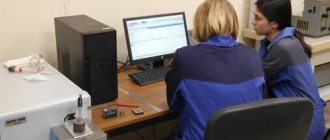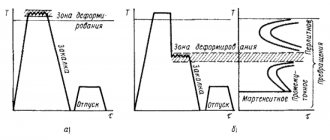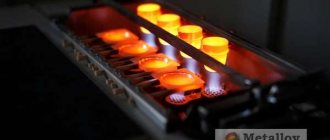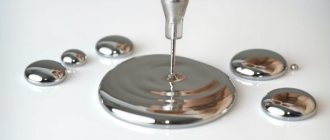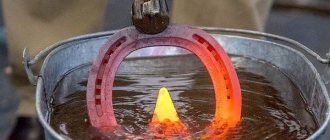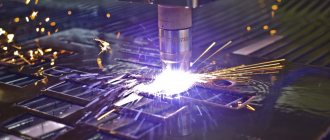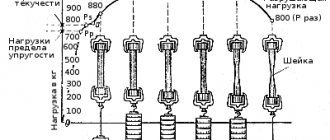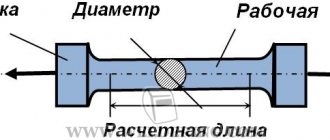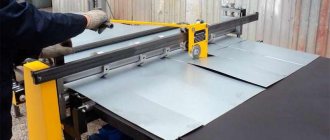Materials science and heat treatment of steels. Methods for studying the structure of metals and alloys
It is customary to distinguish the structure of metals and alloys into: macrostructure, microstructure and fine structure. Depending on the structure of metals and alloys, there are three methods for studying them:
- Macroscopic analysis
- Microscopic analysis
- X-ray structural analysis and X-ray flaw detection
Macroscopic analysis.
Macrostructure is the structure of metals and alloys, which is visible to the naked eye or at low magnifications with a magnifying glass (max. 30 times). Macrostructure is studied through macroanalysis.
Metals are opaque substances and their structure is studied in fractures or specially prepared samples (macrosections). The sample is cut from a certain place, in a certain plane, depending on what is being examined (casting, forging, stamping, rolling, welded or heat-treated part) and what needs to be identified and studied (primary crystallization, heterogeneity of structure, defects that violate the continuity of the metal ). Therefore, samples are cut from one or more places in the ingot (or blank, or part) in both the longitudinal and transverse directions. The surface of the sample (template) is leveled on an emery wheel and then ground. After grinding, the template is etched in special reagents, which dissolve structural components in different ways and etch defects.
Macroanalysis reveals:
- type of fracture (brittle, tough);
- size, shape and location of grains and dendrites of cast metal;
- defects in ingots and castings (shrinkage cavities, gas bubbles, cracks);
- defects that disrupt the continuity of the metal (shrinkage porosity, gas bubbles, cavities, cracks);
- chemical heterogeneity of the metal caused by crystallization processes or created by thermal and chemical-thermal treatment;
- arrangement of fibers in forged and stamped workpieces;
- cracks that occur during pressure treatment or heat treatment, defects in welds.
Microscopic analysis
A more subtle method of studying the structure and defects of metals is microanalysis, i.e. studying the structure of metals at high magnifications using a metallographic microscope.
Microscopic analysis is the study of a surface using light microscopes, where magnification within the range of 50...2000 times allows one to detect structural elements up to 0.2 microns in size.
Metallographic microscopes.
A metallographic microscope examines metal in reflected light (the main difference from a biological microscope, where an object is viewed in transmitted light). Much higher magnification can be obtained using an electron microscope, in which rays of light are replaced by a stream of electrons (up to 100,000 times magnification is achieved).
Transmission microscopes.
A flow of electrons passes through the object being studied. The image is the result of unequal scattering of electrons by an object. There are indirect and direct research methods.
With the indirect method, it is not the object itself that is studied, but its imprint - a quartz or carbon cast (replica), displaying the microsection relief, to prevent secondary radiation, which distorts the picture.
With the direct method, thin metal foils up to 300 nm thick are studied through transmission. Foils are obtained directly from the metal being studied.
Scanning microscopes.
The image is created due to the secondary emission of electrons emitted by the surface onto which a stream of primary electrons continuously moving along this surface falls. The surface of the metal is studied directly. The resolution is slightly lower than that of transmission microscopes.
To study the microstructure, thin sections (microsections) are also prepared. Here, after grinding, additional polishing is carried out to a mirror finish, then the section is etched.
Microanalysis allows you to identify:
- size, shape and location of grains;
- individual structural components of the alloy, on the basis of which the chemical composition of annealed carbon steels can be determined;
- quality of heat treatment (for example, depth of hardening penetration);
- various defects (burnout, decarburization, presence of non-metallic inclusions).
X-ray structural analysis and X-ray flaw detection
X-rays have the same nature as light rays and are electromagnetic vibrations, with a wavelength from 2 x 10-7 to 10-9 cm (the length of light rays from 7.5 x 10-5 to 4 x 10-5 cm).
X-rays are produced in X-ray tubes as a result of the deceleration of electrons when they collide with the surface of a metal. In this case, the kinetic energy of electrons is converted into the energy of x-rays.
X-ray diffraction analysis is based on the ability of atoms to reflect X-rays in a crystal lattice. The reflected rays leave a group of spots or rings on the photographic plate (x-ray). The nature of their arrangement determines the type of crystal lattice, as well as the distance between atoms (positive ions) in the lattice.
X-ray scanning is based on the ability of X-rays to penetrate deep into the body. Thanks to this, it is possible, without cutting metal products, to see on an x-ray image various internal metal defects (shrinkage cavities, cracks, welding defects).
Methods for recording defects in a material are based on the fact that X-rays are partially absorbed when passing through the metal. At the same time, less dense parts of a metal product (areas with defects) absorb rays less than dense parts (solid metal). This leads to the fact that on an x-ray image, areas with defects will have dark or light spots against the background of solid metal.
Modern X-ray machines make it possible to examine steel products to a depth of 60–100 mm.
Gamma rays are used to detect defects in thick metal products. Gamma rays are similar in nature to X-rays, but their wavelengths are shorter. Due to the high penetrating power of gamma rays, they can illuminate steel parts up to 300 mm thick.
Methods for studying the structure of metals
The study of the structure of metals and their alloys determines their suitability for use in various operating conditions. The most important research methods include macro- and microanalysis, X-ray and thermal analysis, as well as flaw detection: magnetic, ultrasonic, using radioactive isotopes. Using macroanalysis , the structure visible to the naked eye or through a magnifying glass is studied using metal fractures and macrosections. For macroanalysis, one of the surfaces of the sample is polished, then it is “etched” with one of the acids. Macroanalysis reveals cracks, gas bubbles, shrinkage cavities, and the arrangement of fibers in rolled products and forgings. The macrostructure of, for example, crankshafts is used to judge their quality. In Fig. Figure 9 shows the arrangement of fibers - correct (a) and incorrect (b).
Fig.9
Microanalysis reveals the structure in microsections with magnification in optical microscopes up to 2500 times, and in electron microscopes - up to 25,000 times. This is the most important analysis that allows you to comprehensively study the quality of the metal, determine the structural components, shape and size of grains, microdefects lying under the surface, non-metallic inclusions, and the quality of heat treatment. Based on the microstructure, it is possible to explain the reasons for unsatisfactory mechanical properties without testing them. Microsections are made by fine grinding or polishing. During etching, various components of the structure dissolve: some grains are weaker, others are stronger; under a microscope they are visible as darker or lighter. X-ray analysis is used to study crystal structures and defects at a certain depth inside a metal. X-rays penetrate a body that is impenetrable to visible light, so it is possible to detect an internal defect without destroying the metal. The penetration depth of X-rays into steel is 100 mm. The study of defects lying at great depths is carried out using γ-rays.
by methods of spectral and chemical analysis . Spectral analysis is carried out using the spectrum obtained from the glow of metals in a hot state. Some metals produce a line of yellow light, others green, etc. In this way, the presence of any metal can be detected, even if its amount is negligible.
Magnetic flaw detection allows you to examine ferromagnetic metals: steel, nickel, cobalt. It detects defects at a depth of up to 2 mm, for example in welds: cavities, cracks, non-metallic inclusions. Defective areas have low magnetic permeability and scatter magnetic field lines that go around these areas, closing in the magnetic poles (Fig. 10).
Ultrasonic flaw detection provides effective quality control of products and workpieces of any metal at great depths. The ultrasonic wave is directed to the surface of the product, penetrates deep and passes through the entire thickness of the metal. In the absence of a defect, sound waves propagate normally.
If a defect is encountered along the way, the intensity of the ultrasound will change. A defect is identified by changes in this intensity.
Ultrasonic flaw detection is widely used in quality control of forgings, rolled products, turbine rotors, rails, etc.
With the help of radioactive isotopes in metallurgy, the penetration of slag into metal and the rate of diffusion of carbon in steel during carburization are detected. They help monitor the wear of machine parts or refractory masonry. The radioactivity of isotopes in worn areas changes due to a decrease in the number of isotopes on the friction surface, resulting in a change in radiation that is easy to detect
Fig.10
Problems solved by the examination of metals, alloys and products made from them (metallurgical examination)
All tasks solved by metallurgical examination can be divided into two large parts - a group of diagnostic tasks and a group of identification tasks. Diagnostic tasks answer questions related to determining the metallic nature of detected objects, as well as determining the characteristics of objects. Identification tasks determine the correspondence of various objects.
Diagnostic tasks:
- finding the smallest particles of metal, as well as metal traces;
- identification of the metal or alloy from which the object is made;
- determination of specific characteristics of the chemical composition of an object.
Identification tasks:
- determination of classification characteristics of the subject under study;
- determining the source of production of the metal products being compared;
- determination of the fact that the parts provided for research belong to the same object.
The list of tasks is determined in each specific case and depends on the final needs of the person who appointed the examination.
Structure of metals. Study methods.
Metal structure analyses: micro-, macro- and fine structure.
The structure of the metal is conventionally divided into micro-, macro- and fine structure.
1. Macrostructure. The macrostructure of the material is studied visually without the use of special equipment or with slight magnification (under a magnifying glass). Inspection helps to evaluate the structure of the alloy after preparing the material (grinding, etching) for further research. Using macrostructural analysis, it is possible to identify: • obvious, continuous defects in workpieces that can cause destruction of the substance (shrinkage porosity, gas bubbles, cracks, cavities); • reasons for the destruction of finished parts; • type of fracture; • localization of casting crystals and dendrites, their shape, size; • chemical heterogeneity of crystallized or created by thermal or chemical treatment of metal; • deformed alloy fibers. 2. Microstructural analysis. The method involves studying the metal at a magnification of 50 - 2000 times with a light microscope, which allows you to see particles up to 0.2 microns. The method is possible by examining the structure in reflected light, so the samples for research are microsections with a polished surface, in which microcracks and non-metallic components can be seen. To ensure the effectiveness of the analysis, the surface is first etched with special reagents, the composition of which depends on the substance being tested. The study of microstructure helps to identify the shape and size of grains, phases and structure of the substance. The use of electron microscopes with higher resolution is also possible when examining metal. Their image appears with the help of a fast stream of flying electron beams (wavelength 0.04 - 0.12) * 10-8 cm. Transmission microscopes - passing a stream of electrons through the sample under study, gives a picture of the inhomogeneous scattering of electrons in the structure of the object. Indirect and direct methods. Indirect analysis does not study the object, but only its imprint, the microsection relief. The method is used to prevent repeated radiation, which distorts the picture. Direct—transmission examination of foil (up to 300 nm). The foil is obtained from the test object. Scanning microscopes help to study the surface of an object and have a slightly lower resolution. The test image is obtained by emitting secondary emission electrons from a surface exposed to a flow of primary electrons. 3. Fine structure. The method is based on studying the atomic-crystalline structure of a solid lattice using X-ray waves. The analysis makes it possible to determine the chemical bond of the alloy, the localization of defects and their concentration, structure, properties, type of solid solutions, stress, and dislocation density. Share this material:
